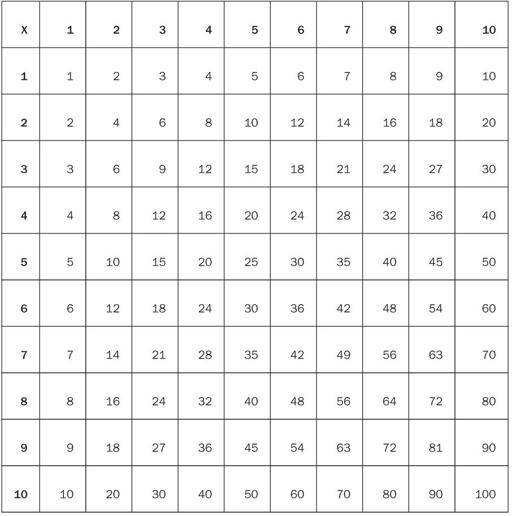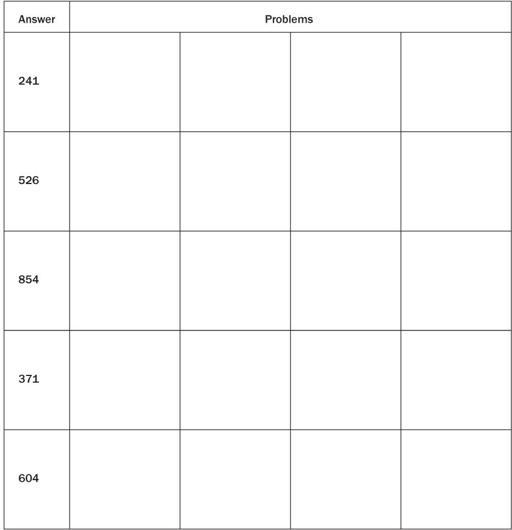Teaching the Common Core Math Standards With Hands-On Activities, Grades 3-5 (8 page)
Read Teaching the Common Core Math Standards With Hands-On Activities, Grades 3-5 Online
Authors: Judith A. Muschla,Gary Robert Muschla,Erin Muschla-Berry
Tags: #Education, #Teaching Methods & Materials, #Mathematics, #General

Names ____________________________________ Date
____________
Multiplication Table
Number and Operations in Base Ten: 3.NBT.1
“Use place value understanding and properties of operations to perform multi-digit arithmetic.”
1. “Use place value understanding to round whole numbers to the nearest 10 or 100.”
Background
Rounding is an important skill in mathematics. To round numbers, students must understand place value.
When rounding to the nearest 10, students must look to the digit in the ones place. If the digit is 5 or more, students must round up to the nearest 10. If the digit is 4 or less, they must round down to the nearest 10. For example, 25 is rounded to 30, but 24 is rounded to 20.
When rounding to the nearest 100, students must look to the digit in the tens place. If the digit is 5 or more, they must round up to the nearest 100. If the digit is 4 or less, they must round down to the nearest 100. For example, 855 is rounded to 900, but 845 is rounded to 800.
Activity: It's Around …
Working in pairs or groups of three, students will round numbers to the nearest 10 and nearest 100.
Materials
Reproducible, “Rounding Numbers,” for each pair or group of students.
Procedure
1.
Distribute copies of the reproducible. Explain that there are two large boxes on the right side of the page. The first contains the numbers 0, 10, 20, 30, 40, 50, and 60. The second contains the numbers 100, 200, 300, 400, 500, 600, and 700. Students will be rounding to these numbers.
2.
Explain that the numbers in the box on the upper left of the page are to be used with the numbers in the box immediately to their right. Students are to consider each number in the box on the upper left, and write it beside the number in the box on the right that it can be rounded to. For example, the numbers 49 and 53 (in the box on the upper left) can both be rounded to the number 50 (in the box directly to the right). Students are to write these numbers in the space beside 50 in the box on the right.
3.
Explain that the numbers in the box on the lower left of the page are to be used with the numbers in the box immediately to their right. Again, students are to consider each number in the box on the lower left, and write it beside the number in the box on the right that it can be rounded to.
Closure
Correct the work as a class. Review any numbers students had difficulty rounding.
Answers
0:
4;
10:
5, 7, 11, 14;
20:
15, 19, 24;
30:
25, 31;
40:
35, 44;
50:
49, 53;
60:
59, 62;
100:
79, 120;
200:
150, 189, 199, 201;
300:
305, 349;
400:
370, 410, 449;
500:
499;
600:
554, 628;
700:
705, 745
Names ___________________________________ Date
____________
Rounding Numbers
Number and Operations in Base Ten: 3.NBT.2
“Use place value understanding and properties of operations to perform multi-digit arithmetic.”
2. “Fluently add and subtract within 1,000 using strategies and algorithms based on place value, properties of operations, and/or the relationship between addition and subtraction.”
Background
Addition and subtraction problems involving two- and three-digit numbers can be classified in two groups: those problems that do not require regrouping and those that do. You may find it helpful to demonstrate and reinforce the meaning of addition and subtraction, especially the concept of regrouping, through modeling with base-10 blocks.
Activity 1: Helping Zero Find a Place
The teacher will read the story
A Place for Zero: A Math Adventure
to the class. Students are to listen to the story, and then write a letter to Zero, explaining how he is important to the other digits.
Materials
One copy of
A Place for Zero: A Math Adventure
by Angeline Sparagna LoPresti (Charlesbridge Publishing, 2003) for the teacher.
Procedure
1.
Read the story
A Place for Zero: A Math Adventure
to your students. The story is about Zero, who feels different from his other digit friends because he believes he has nothing to add.
2.
After reading the story, discuss why Zero feels that he is different.
3.
Ask your students to imagine that they are a digit, one of Zero's friends. They are to write a letter to Zero, explaining why he is important not only to them but also to addition and subtraction.
Closure
Ask for volunteers to read their letters to Zero. You may also want to display the letters of your students.
Activity 2: Finding Sums and Differences
Students will add or subtract two- and three-digit numbers within 1,000.
Materials
Reproducible, “Problem Grid”; a copy of an appropriate problem group (see Preparation) for each student; scissors; reproducible, “Problem Groups,” for the teacher.
Preparation
The reproducible, “Problem Groups,” is divided into three parts: Group 1, Group 2, and Group 3. Group 1 contains addition and subtraction problems that do not require regrouping. Group 2 contains addition and subtraction problems that require regrouping. Group 3 contains a variety of addition and subtraction problems, some that require regrouping and some that do not. Make a copy of the reproducible, select the skills you want your students to work with, and cut out the appropriate problems, which may be Group 1, Group 2, or Group 3. Make enough copies of this group so that each student will receive a copy.
Procedure
1.
Hand out the copies of the “Problem Grid” to your students. Also hand out the copies of the problem group you selected.
2.
Explain that each row on the “Problem Grid” has an answer. Following the answer are four blank squares.
3.
Explain that students should find each sum or difference on their problem group. They are then to write the problem number and the problem in the square in each row that contains the answer to the problem. Note that different problems will have the same answer. Also note that not all squares on the “Problem Grid” will be filled.
Closure
Review students' results and discuss any problems that your students found troublesome.
Answers
Groups, answers, and problem numbers are provided.
Group 1:
241:
5, 8, 15;
526:
6, 10, 13;
854:
3, 4, 7;
371:
1, 9 12, 14;
604:
2, 11;
Group 2:
241:
11, 14;
526:
4, 7, 10, 15;
854:
1, 9, 12, 13;
371:
2, 5;
604:
3, 6, 8;
Group 3:
241:
5, 11, 15;
526:
2, 4, 8, 13;
854:
1, 7, 14;
371:
3, 9;
604:
6, 10, 12
Name ____________________________________ Date
_______________
Problem Grid
Problem Groups





